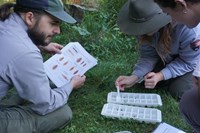- Natural Resource Stewardship and Science Directorate
Teaming Up for Science
- Type: Article
- Offices: Natural Resource Stewardship and Science Directorate

A new partnership began in October 2021 and supports science and stewardship activities that benefit both parks and their local communities. Over the next five years parks and their communities will collaborate to identify and address their scientific priorities. Projects in the first year will focus on water quality, marine biodiversity, and preservation of night skies.
- Type: Article
- Locations: Acadia National Park, Allegheny Portage Railroad National Historic Site, Amistad National Recreation Area, Apostle Islands National Lakeshore, Appalachian National Scenic Trail, more »
- Offices: Air Resources Division, National Natural Landmarks Program, Natural Resource Stewardship and Science Directorate

Read the abstract and get the link to a published paper on a model to predict mercury risk park waterbodies: Kotalik, C.J. et al. 2025. Ecosystem drivers of freshwater mercury bioaccumulation are context-dependent: insights from continental-scale modeling. Environmental Science & Technology. DOI: 10.1021/acs.est.4c07280
- Type: Article
- Locations: Acadia National Park, Allegheny Portage Railroad National Historic Site, Amistad National Recreation Area, Apostle Islands National Lakeshore, Big Bend National Park, more »
- Offices: Air Resources Division, National Natural Landmarks Program, Natural Resource Stewardship and Science Directorate, Wild and Scenic Rivers Program

Read the abstract and get the link to a published paper on how dragonfly mercury studies uncover unexpected atmospheric delivery pathways: Janssen, S.E., C.J. Kotalik, J.J. Willacker, M.T. Tate, C. Flanagan Pritz, S.J. Nelson, D.P. Krabbenhoft, D. Walters, and C. Eagles-Smith. 2024. Geographic Drivers of Mercury Entry into Aquatic Foods Webs Revealed by Mercury Stable Isotopes in Dragonfly Larvae. Environmental Science & Technology. DOI: 10.1021/acs.est.4c02436
- Type: Article
- Locations: Glacier National Park
- Offices: Air Resources Division, Natural Resource Stewardship and Science Directorate
- Type: Article
- Offices: Air Resources Division, Natural Resource Stewardship and Science Directorate
- Type: Article
- Locations: Dinosaur National Monument
- Offices: Air Resources Division, Natural Resource Stewardship and Science Directorate
- Type: Article
- Offices: Air Resources Division, Natural Resource Stewardship and Science Directorate, Wild and Scenic Rivers Program

Learn why mercury research is important at Wild & Scenic Maurice River (New Jersey). Here, a local watershed organization called Citizens United to Protect the Maurice River and Its Tributaries (CU Maurice River) helps sample dragonfly larvae for mercury analysis. The Dragonfly Mercury Project empowers community volunteers and helps protect human health.
- Mount Rainier National Park
Aquatic Citizen Science at Mount Rainier
Last updated: July 21, 2023






